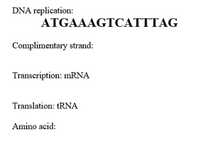
Biochemistry
9th Edition
ISBN: 9781319114671
Author: Lubert Stryer, Jeremy M. Berg, John L. Tymoczko, Gregory J. Gatto Jr.
Publisher: W. H. Freeman
expand_more
expand_more
format_list_bulleted
Concept explainers
Question
BIOCHEMISTRY
Complete the series for

Transcribed Image Text:DNA replication:
ATGAAAGTCATTTAG
Complimentary strand:
Transcription: MRNA
Translation: tRNA
Amino acid:
Expert Solution
This question has been solved!
Explore an expertly crafted, step-by-step solution for a thorough understanding of key concepts.
This is a popular solution
Trending nowThis is a popular solution!
Step by stepSolved in 4 steps

Knowledge Booster
Learn more about
Need a deep-dive on the concept behind this application? Look no further. Learn more about this topic, biochemistry and related others by exploring similar questions and additional content below.Similar questions
- ( please provide answer with diagram step by step in simple language)arrow_forwardUsing the illustration of DNA replication given below label the following:arrow_forwardDNA is a primary source of genetic information in the cell and is the target for many drugs.Describe in detail intercalation and groove binding interactions with DNA and useappropriate illustrations to support your answer. Give specific examples of molecules thatbind by each mode of interaction.arrow_forward
- Use the following information to answer the next question. The DNA strand shown below is thought to contain the genetic code for part of an enzyme B-galactosidase which is involved in lactose metabolism. (Read the DNA beginning at the left.) -A-T-A-T-G-G-G-G-C-A-T-G The second amino acid coded from the section of DNA for B-galactosidase is Select one: a. thymine b. tryptophan c. serine d. threoninearrow_forwardDescribe the structure of DNA as repeated units of nucleotides that consist of nitrogenous bases, sugar and phosphate.arrow_forwarda. As a result of the structure of DNA and RNA, replication, transcription and translation are possible. What can nucleic acids do, as a result of their structure, that enables these processes to occur? The figure below shows a simplified schematic representation of a segment of DNA. The DNA is labelled with the numbers 1 – 14 for easy reference. -35 sequence Pribnow box 5' UTR 3' UTR DNA TTGACA TATAAT -35 -10 Gene a Gene B Gene y 1 2 3 4 5 6 7 8 9 10 11 12 13 14 UTR = untranslated region b. At which position on the DNA (number 1 - 14) will transcription be initiated? c. At which position on the DNA (number 1 - 14) will the first signal for translation be found? d. Between which two regions on the DNA will the polyadenylation signal be found? Use the numbers to indicate the region. e. Between which two regions on the DNA will the first Shine-Dalgarno / Ribosome Binding Sequence be found? Use the numbers to indicate the region.arrow_forward
- Use the terms provided to label the diagram representing the flow of information from DNA to protein. Messenger RNA Translation Polypeptide Codon Transcription DNA template strand DNA coding strand Amino acid ++ !!!! 4arrow_forwardDifferentiate DNA from RNA by completing the tablearrow_forwardTabulate the differences of the various DNA conformations in terms of orientation, rise per base pair (bp), pitch per trun of helix and helix diameter.arrow_forward
- Given the following non-coding strand of DNA nucleotides:G T T C C C T T T G G A A C C T G G Write the nucleotide sequence of the coding strand of DNA:b. Write the nucleotide sequence of mRNA resulting from transcription:c. Using the genetic code, write the amino acid sequence translated:arrow_forwardList six types of DNA repair. Explain the basic features of each.arrow_forwardWrite down the major differences between DNA and RNA.keeping in mind the concept of "central dogma". Explain whether the information from protien is transfered to DNA? If yes/No, explain.arrow_forward
arrow_back_ios
SEE MORE QUESTIONS
arrow_forward_ios
Recommended textbooks for you
 BiochemistryBiochemistryISBN:9781319114671Author:Lubert Stryer, Jeremy M. Berg, John L. Tymoczko, Gregory J. Gatto Jr.Publisher:W. H. Freeman
BiochemistryBiochemistryISBN:9781319114671Author:Lubert Stryer, Jeremy M. Berg, John L. Tymoczko, Gregory J. Gatto Jr.Publisher:W. H. Freeman Lehninger Principles of BiochemistryBiochemistryISBN:9781464126116Author:David L. Nelson, Michael M. CoxPublisher:W. H. Freeman
Lehninger Principles of BiochemistryBiochemistryISBN:9781464126116Author:David L. Nelson, Michael M. CoxPublisher:W. H. Freeman Fundamentals of Biochemistry: Life at the Molecul...BiochemistryISBN:9781118918401Author:Donald Voet, Judith G. Voet, Charlotte W. PrattPublisher:WILEY
Fundamentals of Biochemistry: Life at the Molecul...BiochemistryISBN:9781118918401Author:Donald Voet, Judith G. Voet, Charlotte W. PrattPublisher:WILEY BiochemistryBiochemistryISBN:9781305961135Author:Mary K. Campbell, Shawn O. Farrell, Owen M. McDougalPublisher:Cengage Learning
BiochemistryBiochemistryISBN:9781305961135Author:Mary K. Campbell, Shawn O. Farrell, Owen M. McDougalPublisher:Cengage Learning BiochemistryBiochemistryISBN:9781305577206Author:Reginald H. Garrett, Charles M. GrishamPublisher:Cengage Learning
BiochemistryBiochemistryISBN:9781305577206Author:Reginald H. Garrett, Charles M. GrishamPublisher:Cengage Learning Fundamentals of General, Organic, and Biological ...BiochemistryISBN:9780134015187Author:John E. McMurry, David S. Ballantine, Carl A. Hoeger, Virginia E. PetersonPublisher:PEARSON
Fundamentals of General, Organic, and Biological ...BiochemistryISBN:9780134015187Author:John E. McMurry, David S. Ballantine, Carl A. Hoeger, Virginia E. PetersonPublisher:PEARSON

Biochemistry
Biochemistry
ISBN:9781319114671
Author:Lubert Stryer, Jeremy M. Berg, John L. Tymoczko, Gregory J. Gatto Jr.
Publisher:W. H. Freeman

Lehninger Principles of Biochemistry
Biochemistry
ISBN:9781464126116
Author:David L. Nelson, Michael M. Cox
Publisher:W. H. Freeman

Fundamentals of Biochemistry: Life at the Molecul...
Biochemistry
ISBN:9781118918401
Author:Donald Voet, Judith G. Voet, Charlotte W. Pratt
Publisher:WILEY

Biochemistry
Biochemistry
ISBN:9781305961135
Author:Mary K. Campbell, Shawn O. Farrell, Owen M. McDougal
Publisher:Cengage Learning

Biochemistry
Biochemistry
ISBN:9781305577206
Author:Reginald H. Garrett, Charles M. Grisham
Publisher:Cengage Learning

Fundamentals of General, Organic, and Biological ...
Biochemistry
ISBN:9780134015187
Author:John E. McMurry, David S. Ballantine, Carl A. Hoeger, Virginia E. Peterson
Publisher:PEARSON